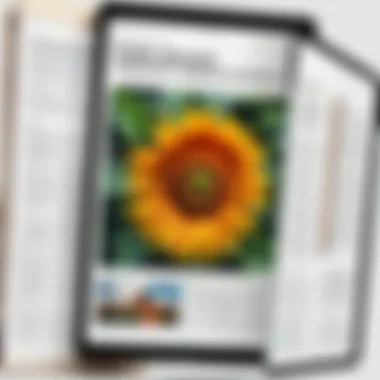Explore Free Books on iPad: Your Ultimate Guide


Intro
In the age of digital reading, the iPad stands out as a versatile tool, allowing users to explore a wide range of literary works without the burden of purchasing every title. The numerous resources online provide free access to books across various genres. This comprehensive guide seeks to inform readers about these platforms. It will spotlight how to navigate them effectively, emphasizing the importance of public domain texts and digital libraries. By utilizing these resources, one can enrich their reading habits, deepen their understanding of different subjects, and cultivate a passion for literature.
Accessing Free Books
Several resources are available for accessing free books on the iPad. These include libraries, specific apps, and websites. Each offers unique advantages and caters to diverse reading preferences.
- Project Gutenberg: This is one of the oldest and most reliable sources for free books. It houses over 60,000 eBooks, mainly consisting of public domain titles. With a user-friendly interface and numerous formats available, it is easy to download books directly onto your iPad.
- Open Library: A part of the Internet Archive, Open Library aims to create a web page for every book ever published. Users can either borrow eBooks or read them online. The variety available is vast, ranging from classics to contemporary works.
- Apple Books: Although predominantly a marketplace for paid books, Apple Books occasionally offers free selections and promotional downloads. It’s integrated with the iPad for a seamless reading experience.
- Libby: This is an app that connects to public libraries. Users can borrow eBooks and audiobooks using their library card. The interface is intuitive, making it easy to browse and borrow books.
Formats and Compatibility
Understanding eBook formats is essential for a smooth reading experience on the iPad. The most common formats include:
- EPUB: Widely used for eBooks. Most apps on the iPad, including Apple Books, support this format.
- PDF: Suitable for fixed-layout content. Most readers can handle this format as well.
- MOBI: Primarily associated with Amazon Kindle, this format is less compatible directly with the iPad but can be converted.
Importance of Public Domain Texts
Public domain literature, those works whose copyrights have expired, allows expansive access to classic literature. Users can read works by authors such as Jane Austen, Mark Twain, and Leo Tolstoy without any cost. These texts not only provide enjoyment but also insight into history, culture, and human emotion.
"Public domain works form the foundation of our literary heritage, enriching our collective learning experience."
Closure
Accessing free books on the iPad is not only feasible but also rewarding. With a wealth of resources available, readers can explore everything from classic literature to contemporary works. Embracing public domain texts and leveraging digital libraries can lead to a broader understanding and appreciation of literature. By integrating this knowledge, tech-savvy readers can enhance their reading experiences significantly.
Foreword to Free Reading Resources
Accessing literature has transformed dramatically in recent years. With technology at the forefront, readers now enjoy a multitude of ways to engage with written content. This section discusses the significance of free reading resources available on the iPad, a device widely embraced by tech-savvy individuals. The ease of portability allows users to carry many titles in a single device, making classical and modern literature accessible anytime, anywhere.
Free books present a unique opportunity to explore diverse genres without financial constraints. This appeals particularly to those who wish to expand their horizons beyond conventional publishing. Moreover, these resources contribute to knowledge enhancement and literacy promotion.
"In a world where information is abundant, free books are gateways to learning and imagination."
Digital reading resources also include various formats suited for iPads, such as ePub and PDF. Understanding these formats is crucial for a smooth reading experience. Additionally, exploring the platforms that provide free literature empowers readers to make informed choices about their reading habits.
Thus, this article aims to demystify free reading resources by highlighting their benefits and showcasing key platforms to access a wealth of knowledge at no cost.
The Landscape of Digital Reading
Digital reading encompasses an expansive terrain where technology changes how we consume books. The advent of e-readers, tablets like the iPad, and smartphones has shifted reading from paper pages to glowing screens. This transition brings several advantages. First, access to thousands of titles is available at the fingertips of readers. Second, digital formats often come with features like adjustable font sizes and background colors, which enhance user experience.
Furthermore, digital libraries continue to expand their catalogs, accommodating various preferences, from classic literature to contemporary works. This vast availability has democratized access to literary resources, encouraging more individuals to engage with reading.
Why Choose Free Books?
Opting for free books is not merely about saving money; it embodies a philosophical stance towards accessibility and education. Free literature allows users to explore works they might otherwise resist purchasing. This fosters a readership that is curious and open to diverse cultures, thoughts, and ideas.
Additionally, free books support the concept of lifelong learning. Readers seeking to improve their knowledge or skills can find a trove of resources on any subject through free platforms. The variety also enables readers from different backgrounds and interests to discover new genres that pique their interest and expand their literary taste.


In summation, engaging with free reading resources on the iPad forms an integral part of contemporary reading culture. It empowers individuals with knowledge, places literature within reach, and encourages an inclusive approach to education.
Platforms for Free Books on iPad
In the modern age, the iPad serves as a versatile tool for accessing various media, with reading being a significant component. The platforms available for free books on the iPad play an essential role in enhancing the reading experience. Given the vast digital landscape, these platforms not only offer considerable content but also improve accessibility and usability for readers. By knowing where to find these resources, readers can tap into a wealth of literary material without any financial burden.
Each platform mentioned here stands out due to its unique offerings, user interfaces, and compatibility features, making it easier to navigate through countless titles. Delving into these platforms gives readers options that suit their preferences and reading habits.
Kindle App: Access to a Vast Library
The Kindle App offers iPad users access to an immense library of titles, providing a seamless reading experience. This application can be downloaded from the App Store and is easy to set up, making it accessible to both seasoned readers and new users.
A key advantage of the Kindle App is its integration with Amazon's vast collection. While most high-profile books require purchase, the app also features a significant number of free eBooks across various categories including classics, contemporary fiction, and non-fiction works. Users can easily search these titles and take advantage of Amazon's robust catalog without spending a dime.
Additionally, the Kindle App provides features such as adjustable text sizes, night mode for reading in low light, and the ability to highlight text. All of these elements ensure an enjoyable reading experience that can cater to personal preferences.
Apple Books: Curated Selection of Free Titles
Apple Books, known for its clean interface and user-friendly design, presents a curated selection of free titles. The app is pre-installed on most iPads, making it easily accessible for users right out of the box.
In the Apple Books store, readers can find various categories and genres of books that are offered at no cost. This selection is continually updated, ensuring that users can find fresh material regularly. Each title often includes user reviews and ratings, providing insights into its quality and appeal.
Moreover, the Apple Books app supports several reading features that enhance the user experience. Users can easily customize their reading layout, switch between light and dark modes, and sync bookmarks across devices. These features combine to create a pleasant environment for readers, encouraging them to explore new titles regularly.
Google Play Books: Extensive Free Collection
Google Play Books stands out due to its extensive collection of free eBooks. The app, downloadable from the App Store, allows users to access a wide range of genres, making it a versatile platform for readers.
One appealing feature of Google Play Books is its collaborative syncing with other Google services. If users have a Google account, they can seamlessly access their reading lists across multiple devices, eliminating the need for manual updates. This ensures that a reader can pick up where they left off, regardless of the device they use.
In addition to free titles, Google Play Books also offers a range of preview samples for paid eBooks. While this does not provide a full reading experience, it helps users determine whether to invest in a specific title. The platform maintains a straightforward interface, making it easy to navigate through various titles and categories.
Project Gutenberg: A Treasure Trove of Classics
Project Gutenberg deserves special mention for its vast repository of public domain texts. With over 60,000 free eBooks available, it serves as a treasure trove for readers interested in classic literature. This platform is entirely free and requires no registration.
Users can easily access Project Gutenberg through their web browser on the iPad. The site features a simple layout, allowing for quick searches of authors and titles. It is worth noting that while the focus is on classics, users may also find lesser-known works that can be of great interest.
The texts are primarily in ePub and Kindle formats, making them compatible with various reading apps on the iPad. Furthermore, csv support allows for easy downloading and ensures that users can choose their preferred format without difficulty. Readers simply cannot overlook the wealth of literary history available at their fingertips through Project Gutenberg.
Digital Libraries Offering Free eBooks
Digital libraries represent a significant advancement in making literature accessible to larger audiences. In the context of free eBooks, these platforms serve not just as repositories but as gateways to a plethora of literary works that span various genres, periods, and authors. Their importance in this guide is twofold: they enhance the accessibility of literature and they foster a culture of reading and knowledge sharing. Users can delve into classic literature or discover contemporary works without the barrier of cost, which is crucial during economically challenging times.
Open Library: A Global Initiative
Open Library aims to create a web page for every book ever published. This ambitious project, supported by the Internet Archive, includes millions of eBooks that are freely available to read or borrow. Users can sign up to get digital loans of various titles, thus having access to a limitless library experience across genres.
A key feature of Open Library is its user-friendly interface. Navigating through the site is rather easy. The search function allows users to find titles quickly, and they can explore lists by authors, subjects, or even formats. In addition, the accessibility is notable, with many works available in multiple languages, catering to a diverse global audience. This broad scope not only enriches the reading experience but also encourages cross-cultural understanding.
Internet Archive: Beyond Books


The Internet Archive is not limited to just eBooks. It serves as a vast digital library that includes audio, video, and archived web pages, along with millions of texts. The scope of the Internet Archive allows users to explore literature in a larger context of historical and contemporary documents.
A distinctive aspect of the Internet Archive is its mission to provide
Public Domain Texts: What You Need to Know
Public domain texts form an essential part of the literary landscape, particularly for readers seeking enriching content without the monetary burden. These texts, often comprising classic literature, historical documents, and other cultural works, provide an avenue for extensive literary exploration. Understanding public domain literature is crucial for anyone engaging with free reading resources on their iPads. The significance of public domain texts lies not only in their availability but also in their potential to inspire and educate.
Defining Public Domain Literature
Public domain literature refers to works whose copyrights have expired, meaning they are no longer protected by copyright laws. This allows anyone to use, share, and adapt these texts freely. Factors influencing a work's status in the public domain include:
- Expiration of copyright: Most original works have a lifespan for copyright protection, typically lasting several decades after the author's death.
- Government works: Many works created by government employees or agencies are automatically placed in the public domain upon creation.
- Many older texts: Classical literature such as works by William Shakespeare, Jane Austen, or Mark Twain can often be found in the public domain due to their age.
This increase in access to literature is a critical element enriching the reading options for iPad users. Readers can explore a myriad of genres and styles without any cost.
Finding Public Domain Works
Locating public domain works has become far more accessible thanks to modern technology. Here are key platforms and methods to consider when searching for these texts:
- Project Gutenberg: This online library offers over 60,000 free eBooks, primarily focusing on literature that has entered the public domain. The user-friendly interface simplifies the search process.
- Internet Archive: Beyond mere books, the Internet Archive provides access to a vast array of public domain works in various formats, including video and audio, catering to different tastes.
- Library of Congress: The Library's digital collections often include public domain texts, enabling far-reaching access to historical writings and documentation.
- Local Libraries: Many local libraries have digital collections that support public domain literature, especially under open library initiatives.
Public domain texts are a gateway to literary treasures that can enhance your reading experience without any financial constraints. Accessing these works will broaden your understanding and appreciation of literary history.
In summary, public domain texts present an invaluable resource for avid readers seeking quality literature without cost. Understanding how to access these texts empowers readers, making the iPad a versatile tool for literary exploration.
eBook Formats and Compatibility with iPad
Understanding the compatibility of eBook formats on the iPad is crucial for enhancing the reading experience. Different formats can influence how a book looks and functions on the device. This section will cover key aspects of eBook formats, such as ePub and PDF, as well as the best reading apps available for iPad users.
Understanding ePub and PDF Formats
ePub and PDF are the two predominant formats available for digital books. ePub stands out as a versatile format specifically designed for reflowable content. This means it can adjust text size and layout, offering a seamless reading experience on various screen sizes, including the iPad. It is also generally supported by multiple reading apps, making it a popular choice.
PDF, however, is different. It maintains a fixed layout, which is useful for complex documents with intricate designs. This can be a double-edged sword. On one hand, it preserves the appearance of the original document. On the other hand, it may not adapt well to smaller screens, sometimes requiring zooming and panning to read. Some users may find PDF less convenient on iPads due to this limitation.
In summary, users should consider their reading habits. For narratives or books with significant text, ePub is often preferable. For documents that rely heavily on layout, such as academic journals or graphic novels, PDF might be the better choice.
Best eBook Readers for iPad
Choosing the right eBook reader app is vital for enhancing your reading experience on the iPad. Here are some of the standout options:
- Kindle App: The Kindle app allows access to Amazon's extensive library of eBooks, including many free titles. It supports both ePub and PDF formats, making it adaptable to various reading needs.
- Apple Books: This is the default reading app for iPads, offering a curated selection of titles, including many free options. Apple Books supports ePub and PDF formats and provides an integrated reading experience with features such as highlights and notes.
- Google Play Books: This app excels in offering a wide range of free books and supports PDF uploads. It's user-friendly, and integrates well with Google's ecosystem.
- Kobo Books: The Kobo app is another solid option, particularly for users invested in the Kobo ecosystem. It emphasizes reading stats and community features, adding a social dimension to reading.
When selecting an eBook reader, consider both the format support and user interface. A clean layout and efficient navigation can significantly enhance the reading experience, proving essential for tech-savvy individuals.
"Selecting the right eBook format and reader app can transform the iPad into a personalized reading haven. "
Utilizing Free Books to Encourage Reading


Accessing free books can play a significant role in fostering a culture of reading among consumers, especially for those who own an iPad. The vast array of free titles allows readers to explore new genres without financial constraints. This is crucial for anyone looking to expand their literary horizons. Additionally, it presents opportunities for those who might not typically invest in books. By having the option to access literature without a cost, individuals may develop an appetite for exploring various authors, styles, and topics.
Furthermore, free books can be an essential tool for parents aiming to nurture a reading habit in their children. Providing kids with access to diverse reading materials encourages them to engage with texts and foster a lifelong love of reading.
Building a Personal Library
Creating a personal library filled with free books on an iPad can be an enriching experience. Rather than only relying on a few favorite titles, readers can diversify their collections. They can explore classics from Project Gutenberg or contemporary works from online repositories.
When you collect eBooks, it’s possible to curate your interests. Keep in mind these considerations when building your library:
- Organize by Genre: Grouping books by type makes exploration easier. Some may prefer fiction, while others favor biographies or historical texts.
- Track Readings: Keeping track of what you have read and what you want to read can enhance the experience. Consider using simple reading logs or apps designed for this purpose.
- Explore Reviews: Before adding titles to your library, it may help to read reviews. This can guide your selections and expand your interests.
In this manner, your library transforms into a personal repository of knowledge and entertainment.
Creating a Reading Habit
Developing a reading habit is integral to reaping the benefits of free books. The convenience of having access to numerous titles on an iPad can facilitate this process. One effective strategy is setting aside dedicated reading time each day. Whether it is during breaks, before bedtime, or any quiet time, consistency is key.
Here are some tips to help establish a reading routine:
- Set Realistic Goals: Start with manageable amounts of reading each day, gradually increasing as you build the habit.
- Limit Distractions: Creating a comfortable reading environment, free from distractions, can help focus on the text.
- Join Online Reading Groups: Engaging with online communities, like those on Reddit or Facebook, can provide motivation and inspiration.
Cultivating a reading habit through free resources can lead to lifelong learning and personal growth.
In summary, utilizing free books available on platforms such as Apple Books and Project Gutenberg can encourage readers to delve deeper into literature. More than just finding titles, it’s about cultivating an engaging experience that promotes a sustained reading habit.
Challenges of Accessing Free Books
Accessing free books sounds enticing. However, there are challenges. These hurdles can affect the reading experience of many users. Understanding these issues is important in making informed choices.
Digital Rights Management (DRM)
Digital Rights Management, often abbreviated as DRM, is a major factor that affects accessing free books. This technology controls the use of digital content. Therefore, it aims to prevent illegal distribution. Yet, it can sometimes restrict legitimate users too. For instance, a book downloaded from a free source might have limitations. Users may find they can only read it in specific apps or devices. This restriction can frustrate readers who prefer flexibility. Additionally, DRM can affect sharing books among friends or family. Some platforms implement strict policies that prevent sharing altogether. In summary, while DRM protects authors' rights, it can complicate access for readers who seek free literature.
Quality of Free eBooks
The quality of free eBooks varies significantly. Some titles are of excellent quality, while others may not be up to standard. Poor formatting, spelling mistakes, and incorrect layout can detract from the reading experience. Many free books come from user-generated sources. This often leads to inconsistency in editing and formatting. For example, a classic novel may be poorly scanned or poorly converted to digital format. In contrast, many respected sources like Project Gutenberg offer well-curated collections. These are typically free from such issues. Therefore, readers need to be discerning. When selecting free eBooks, it is advisable to check user reviews or ratings when available. This helps ensure a better reading experience and aids in avoiding disappointment.
"The enjoyment of reading can be hindered when content quality does not meet expectations."
Ending and Future of Free Digital Literature
The conclusion of this guide emphasizes the significance of accessing free digital literature. It not only enhances the reading experience for users but also democratizes information and knowledge. The future of free eBooks is bright, and this enlightenment is worth further exploration.
Trends in Digital Publishing
Digital publishing continues to evolve rapidly. Various trends influence how free digital literature is distributed and accessed.
- Self-Publishing: More authors opt for self-publishing, leading to an increase in free content. This empowers writers and allows readers more choices.
- Collaborative Platforms: Platforms like Wattpad and Scribophile provide spaces where writers can distribute work freely, fostering vibrant literary communities.
- Increased Accessibility: Developers are focusing on apps that enable easy access to free books, enhancing usability and user satisfaction.
- Subscription Models: Services that combine access to large libraries with a subscription fee trend towards offering a limited number of free titles, enticing potential subscribers.
These trends indicate that the future of digital literature can encompass a wider range of voices and styles, further enriching the literary landscape.
The Role of Technology in Literature Access
Technology is a crucial element that affects the availability and accessibility of literature. It presents several benefits:
- Cross-Platform Compatibility: Free eBooks can now be read on various devices, including iPads, smartphones, and computers. This flexibility permits readers to access literature anytime.
- Enhanced Search Features: Digital platforms offer powerful search functionalities. Readers can quickly find specific genres or titles, improving their experience significantly.
- Social Elements: Many literary platforms incorporate social features, allowing users to share recommendations and reviews, creating a community around literature.
- AI and Personalized Reading Suggestions: Algorithms now assist readers in discovering free books that align with their interests. This personal touch enhances reading experiences and keeps readers engaged.



